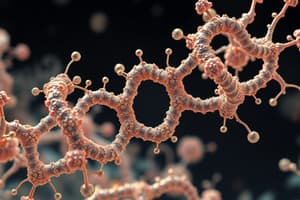Podcast
Questions and Answers
What is the primary function of an enzyme?
What is the primary function of an enzyme?
- To transport molecules across cell membranes
- To serve as a structural component in cells
- To store energy for cellular processes
- To act as a biological catalyst that increases reaction rates (correct)
Which statement about enzymes is true?
Which statement about enzymes is true?
- All enzymes are purely carbohydrate-based.
- Enzymes can function without any cofactors.
- Some enzymes are stereospecific and only act on specific isomers. (correct)
- Enzymes can only catalyze reactions involving organic compounds.
What does the induced-fit model describe about enzyme activity?
What does the induced-fit model describe about enzyme activity?
- The substrate fits precisely into the active site without modification.
- The active site is changed to better fit the substrate. (correct)
- The enzyme is always active, regardless of substrate presence.
- The substrate is broken down before entering the active site.
Which type of enzyme is responsible for hydrolysis reactions?
Which type of enzyme is responsible for hydrolysis reactions?
What term describes the non-protein part of an enzyme necessary for its function?
What term describes the non-protein part of an enzyme necessary for its function?
In competitive inhibition, how does the inhibitor affect enzyme function?
In competitive inhibition, how does the inhibitor affect enzyme function?
What is the role of amino acids in the active site of enzymes?
What is the role of amino acids in the active site of enzymes?
Which of the following describes an isomerase?
Which of the following describes an isomerase?
What characterizes noncompetitive inhibition?
What characterizes noncompetitive inhibition?
What does the active site of an enzyme do?
What does the active site of an enzyme do?
Which process involves the product of an enzyme-catalyzed reaction inhibiting an earlier reaction?
Which process involves the product of an enzyme-catalyzed reaction inhibiting an earlier reaction?
Which of these is NOT a major group of enzymes?
Which of these is NOT a major group of enzymes?
Which of the following enzymes specifically catalyzes peptide bonds formed by the carboxyl groups of Lys and Arg?
Which of the following enzymes specifically catalyzes peptide bonds formed by the carboxyl groups of Lys and Arg?
Which amino acid is NOT among the five most important in enzyme active sites?
Which amino acid is NOT among the five most important in enzyme active sites?
What is a proenzyme (zymogen)?
What is a proenzyme (zymogen)?
How do enzymes affect activation energy in chemical reactions?
How do enzymes affect activation energy in chemical reactions?
What is the role of a competitive inhibitor in enzyme activity?
What is the role of a competitive inhibitor in enzyme activity?
Which factor does NOT affect the rate of an enzyme-catalyzed reaction?
Which factor does NOT affect the rate of an enzyme-catalyzed reaction?
In which scenario would a noncompetitive inhibitor be effective?
In which scenario would a noncompetitive inhibitor be effective?
What happens to enzyme activity as substrate concentration increases?
What happens to enzyme activity as substrate concentration increases?
Which of the following best describes the lock-and-key model of enzyme action?
Which of the following best describes the lock-and-key model of enzyme action?
How does temperature generally affect enzyme activity?
How does temperature generally affect enzyme activity?
What defines an enzyme's active site?
What defines an enzyme's active site?
How does pH influence enzyme activity?
How does pH influence enzyme activity?
What happens to trypsinogen to activate it?
What happens to trypsinogen to activate it?
What term describes an enzyme that is regulated by a change occurring at a site other than its active site?
What term describes an enzyme that is regulated by a change occurring at a site other than its active site?
Which of the following describes negative modulation in allosteric enzymes?
Which of the following describes negative modulation in allosteric enzymes?
Which of the following is an example of protein modification affecting enzyme activity?
Which of the following is an example of protein modification affecting enzyme activity?
What is an isoenzyme?
What is an isoenzyme?
Which forms of lactate dehydrogenase predominately exist in specific tissues?
Which forms of lactate dehydrogenase predominately exist in specific tissues?
What is the result of binding a positive modulator to an allosteric enzyme?
What is the result of binding a positive modulator to an allosteric enzyme?
What is the role of a regulator in allosteric enzymes?
What is the role of a regulator in allosteric enzymes?
Flashcards
Biological catalysts
Biological catalysts
Enzymes that speed up chemical reactions in living organisms.
Apoenzyme
Apoenzyme
The protein component of an enzyme, excluding any cofactors.
Cofactor
Cofactor
A nonprotein substance that assists enzyme activity, often a metal ion.
Coenzyme
Coenzyme
Signup and view all the flashcards
Substrate
Substrate
Signup and view all the flashcards
Active site
Active site
Signup and view all the flashcards
Activation
Activation
Signup and view all the flashcards
Inhibition
Inhibition
Signup and view all the flashcards
Competitive inhibitor
Competitive inhibitor
Signup and view all the flashcards
Noncompetitive inhibitor
Noncompetitive inhibitor
Signup and view all the flashcards
Enzyme activity
Enzyme activity
Signup and view all the flashcards
Lock-and-key model
Lock-and-key model
Signup and view all the flashcards
Induced-fit model
Induced-fit model
Signup and view all the flashcards
Catalytic power
Catalytic power
Signup and view all the flashcards
Feedback control
Feedback control
Signup and view all the flashcards
Proenzyme (zymogen)
Proenzyme (zymogen)
Signup and view all the flashcards
Allosterism
Allosterism
Signup and view all the flashcards
Negative modulation
Negative modulation
Signup and view all the flashcards
Positive modulation
Positive modulation
Signup and view all the flashcards
Regulator
Regulator
Signup and view all the flashcards
Protein modification
Protein modification
Signup and view all the flashcards
Phosphorylation
Phosphorylation
Signup and view all the flashcards
Isoenzyme
Isoenzyme
Signup and view all the flashcards
Lactate dehydrogenase (LDH)
Lactate dehydrogenase (LDH)
Signup and view all the flashcards
Enzyme concentration effect
Enzyme concentration effect
Signup and view all the flashcards
Substrate concentration effect
Substrate concentration effect
Signup and view all the flashcards
Temperature effect on enzymes
Temperature effect on enzymes
Signup and view all the flashcards
pH effect on enzymes
pH effect on enzymes
Signup and view all the flashcards
Study Notes
Enzyme Catalysis
- Enzymes are biological catalysts.
- Enzymes are mostly proteins, with the exception of some RNA molecules that catalyze self-cleavage.
- Enzymes can increase the rate of a reaction by a factor of 10^9 to 10^20.
- Some enzymes catalyze the reaction of only one compound.
- Some enzymes are stereospecific.
- Some enzymes catalyze reactions of specific types of compounds or bonds.
Classification of Enzymes
- Enzymes are commonly named after the reaction or reactions they catalyze.
- Enzymes are classified into six major groups:
- Oxidoreductases: oxidation-reduction reactions.
- Transferases: group transfer reactions.
- Hydrolases: hydrolysis reactions.
- Lyases: addition of groups to a double bond, or removal of groups to create a double bond.
- Isomerases: isomerization reactions.
- Ligases: the joining of two molecules.
Terms in Enzyme Chemistry
- Apoenzyme: the protein part of an enzyme.
- Cofactor: a nonprotein portion of an enzyme that is necessary for catalytic function, like metallic ions.
- Coenzyme: a nonprotein organic molecule that acts as a cofactor, often a B vitamin.
- Substrate: the compound or compounds whose reaction an enzyme catalyzes.
- Active site: the specific portion of the enzyme to which a substrate binds during reaction.
Terms in Enzyme Chemistry (Continued)
- Activation: any process that initiates or increases the activity of an enzyme.
- Inhibition: any process that makes an active enzyme less active or inactive.
- Competitive inhibitor: any substance that binds to the active site of an enzyme thereby preventing binding of substrate.
- Noncompetitive inhibitor: any substance that binds to a portion of the enzyme other than the active site and thereby inhibits the activity of the enzyme.
Enzyme Activity
- Enzyme activity is a measure of how much a reaction rate is increased.
- How much an enzyme activity is influenced by:
- Enzyme concentration
- Substrate concentration
- Temperature
- pH
Lock-and-key Model
- The enzyme is a rigid three-dimensional body.
- The enzyme surface contains the active site.
Induced-fit Model
- The active site becomes modified to accommodate the substrate.
Mechanism of Action
- Both the lock-and-key model and the induced-fit model emphasize the shape of the active site.
- The most important factor is the chemistry of the active site.
- Five amino acids participate in the active sites of more than 65% of enzymes.
Catalytic Power
- Enzymes provide an alternative pathway for reaction with a lower activation energy.
- This results in a faster rate.
Enzyme Regulation
- Feedback control: an enzyme-regulation process where the product of a series of enzyme-catalyzed reactions inhibits an earlier reaction in the sequence.
Enzyme Regulation (Continued)
- Proenzyme (zymogen): an inactive form of an enzyme that must have part of its polypeptide chain hydrolyzed and removed before it becomes active.
Enzyme Regulation (Continued)
- Trypsin, a digestive enzyme, is an example of a proenzyme.
- Trypsinogen is initially inactive.
- It becomes active after a six-amino acid fragment is hydrolyzed and removed from its N-terminal end.
- This removal changes the primary and tertiary structure, allowing the molecule to become active.
Enzyme Regulation (Continued)
- Allosterism: enzyme regulation based on an event occurring at a place other than the active site that creates a change in the active site.
- Allosteric enzyme: An enzyme regulated by this mechanism.
- Negative modulation: inhibition of an allosteric enzyme.
- Positive modulation: stimulation of an allosteric enzyme.
- Regulator: a substance that binds to an allosteric enzyme.
Enzyme Regulation (Continued)
- Protein modification: the process of affecting enzyme activity by covalently modifying it.
- Phosphorylation/dephosphorylation: a common example.
- Pyruvate kinase (PK) is active.
- Phosphorylation inactivates the enzyme to pyruvate kinase phosphate (PKP).
Enzyme Regulation (Continued)
- Isoenzyme: an enzyme that occurs in multiple forms, each catalyzing the same reaction.
- Lactate dehydrogenase (LDH) is an example.
- LDH catalyzes the oxidation of lactate to pyruvate.
- The enzyme is a tetramer of H and M chains.
- H4 is predominantly in heart muscle.
- M4 is predominantly in the liver and skeletal muscle.
- H3M, H2M2, and HM3 also exist.
Studying That Suits You
Use AI to generate personalized quizzes and flashcards to suit your learning preferences.





